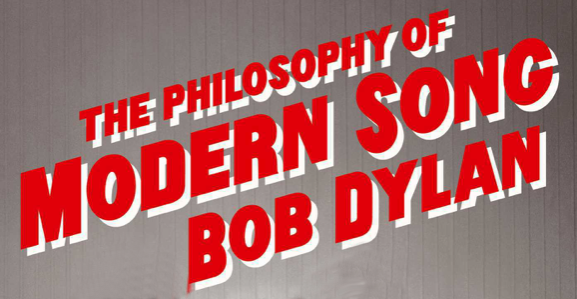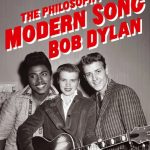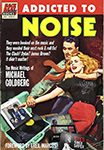
By Michael Goldberg.
In his new book, Dylan riffs on over five dozen songs that he digs and reveals himself in ways he might not have anticipated
The Philosophy of Modern Song, Bob Dylan (Simon & Schuster, 340 pages)
 So the first thing you need to do, once you have Bob Dylan’s new book in hand, is put it aside and call up the Spotify playlist for the book, which is conveniently titled Bob Dylan – The Philosophy of Modern Song, and give it a listen. (If you don’t have Spotify, and you don’t own copies of the songs, you likely can find them at YouTube—but one way or the other, you need to listen to them before you read about them.)
So the first thing you need to do, once you have Bob Dylan’s new book in hand, is put it aside and call up the Spotify playlist for the book, which is conveniently titled Bob Dylan – The Philosophy of Modern Song, and give it a listen. (If you don’t have Spotify, and you don’t own copies of the songs, you likely can find them at YouTube—but one way or the other, you need to listen to them before you read about them.)
Listening to the 66 songs back-to-back in the order Dylan intends, it all makes sense. All those years of programming his Theme Time Radio Hour made Dylan a master of the playlist and that’s one way you could look at this book—as a deeply annotated playlist.
If you’re unfamiliar with many of the songs, Dylan’s list could really throw you off, I mean you could be thinking, “what the hell?” At one point he’s got Rosemary Clooney’s “Come On-A My House” into Johnny Cash’s “Don’t Take Your Guns to Town” into Judy Garland’s “Come Rain Or Come Shine” into Nina Simone’s “Don’t Let Me Be Misunderstood” into Frank Sinatra’s “Strangers In The Night” into Elvis’ “Viva Las Vegas.” It gets even more eclectic at other points in the list.
While I would expect a record like Jimmy Wages’ unreleased-at-the-time-of-its-recording Sun Records rockabilly number, “Take Me (From This Garden Of Evil)” to be included, I’m still scratching my head over the “Whiffenpoof Song.”
To really appreciate this book you need to put aside any of your prejudices against particular genre’s of music and particular artists. When I was younger I turned my nose up at Frank Sinatra and Perry Como and Jimmy Webb and pretty much everything that wasn’t rock or blues or jazz. But over the years I pushed myself to appreciate country music and world music and bluegrass and ‘50s pop singers like Sinatra and Bobby Darin and Vic Damone and, yes, Perry Como. Even so, when I first got the book, before I listened to the playlist, I looked through it and I just didn’t get it. Where were all the old folk songs and blues numbers and hillbilly music that I knew Dylan dug?
We don’t know Dylan’s reasoning in picking the songs for the book, and despite the title, Dylan’s writing almost never addresses the “philosophy of modern song.” Nearly everything he writes here is indirect. I think he believes these songs are great examples of modern songwriting, but I’m guessing. Many approaches to songwriting are presented and I think a young (or old) songwriter can likely learn plenty from enjoying the recordings and studying the writing—the music and the lyrics.
There’s one problem with The Philosophy of Modern Song, and that’s how Dylan characterizes women. Reading the book, you might think he doesn’t like women much. Of the 66 songs, only two were written entirely by women: the late Sharon Sheeley composed the Ricky Nelson hit, “Poor Little Fool” and country singer/musician Cousin Emmy (Cynthia May Carver) wrote the Osborne Brothers hit “Ruby, Are You Mad At Your Man?” (Women share writing credits with men on a handful of other songs.) Only four women sing the songs recounted here (sixty-two are sung by men or male groups): Cher’s “Gypsies, Tramps and Thieves,” “Rosemary Clooney’s “Come On-A My House,” “Judy Garland’s “Come Rain or Come Shine” and Nina Simone’s “Don’t Let Me Be Misunderstood.”
More than that, in his discussions of the individual songs, over and over Dylan stereotypes women in the worst ways. For some of the songs, Dylan writes what his publisher calls “dream-like riffs,” sometimes poetic, often seemingly stream-of consciousness impressions meant to capture the vibe of the song; this is often, but not always, followed by a journalistic critique. While Dylan rips into men in many of his riffs and essays, that doesn’t excuse his worst comments about women.
In the “riff” for the second song in the book, Elvis Costello’s “Pump It Up,” Dylan writes, “You’re the alienated hero who’s been taken for a ride by a quick-witted hellcat, the hot-blooded sex starved wench that you depended on so much, who failed you… And what about the little she goat that won’t go away? You want to maim and mangle her. You want to see her in agony…” Writing about the Santana hit “Black Magic Woman,” Dylan riffs, “…she’s the bad fairy, the evil genius who turns you into a werewolf, gives you horns and a cloven hoof, but you have no other option. … Her voice gets on your nerves—the low drone, the squeaking sounds, the singsong voice can sound like a cow, a bird, a horse, or the bark of a dog… She’s your champion bull-dyke, your spider woman, your hoochie coochie queen…”
Riffing on the Eagles “Witchy Woman”: “The lips of her c**t are a steel trap, and she covers you with cow shit—a real killer-diller and you regard her with suspicion and fear, rightly so. Homely enough to stop a clock, she’s no pussycat… There’s something about her that you can’t shake, could be the uppers and downers, goofballs, hydroxy steroids or gold heroin. …”
OK, so if you can deal with Dylan’s misogyny, there is a lot that is worthwhile and unexpected in the book. At times though, I wondered if Dylan is putting us on? There is a lot of humor in the book, and strange sidebars. He goes on for over a page in his essay on Pete Seeger’s “Waist Deep in the Big Muddy” about lemmings and how the “oft-repeated belief that lemmings follow each other off cliffs in mass ritualistic suicide” is not true. More than a full page is spent on the science fiction writer Leigh Brackett. Why? Don’t ask me. Maybe because this is Bob Dylan and he can do anything he wants. I mean who would dare to edit Bob Dylan?
His writing has a different tone than in his memoir, Chronicles: Volume One. Sometimes it’s very straightforward journalism, as in the rare instance when he writes about songwriting within his “Black Magic Woman” essay. Discussing Tin Pan Alley “moon/June/spoon” rhyme schemes, Dylan writes, “But it is important to remember that these words were written for the ear and not for the eye. And as in comedy, where a seemingly simple sentence can transform into a joke through the magic of performance, an inexplicable thing happens when words are set to music. The miracle is their union.”
When Dylan is riffing, it’s a whole other thing. Listen to him riff on The Temptations “Ball of Confusion”: “In this song everything goes off track. The Earth’s terrestrial axis seems to have tilted a bit, and radical climate changes are threatening the planet. Chaos everywhere—prejudice and death, starvation, destruction. It’s rolling like a ball and you’re packed inside of it. These are turbulent times, and the sons of dogs are roaming the streets. Anarchy breaking out. The air is full of poison and the whole city is disorganized, none of the parts in place. Your money doesn’t buy you anything, or influence anybody. You’re walking unsteady, get going they say, and you’re marching along, confiding in the great Googa Mooga, your personal deity. The hostility and disorder are like a horrible dream, you feel singled out and closed off. …”
So, should you spend $45 on this book? If you have to ask, you probably already know the answer. Me, I’m glad I have a copy. Dylan has introduced me to many songs I had either dismissed, or never heard. Let me leave you with this: again, quoting from “Black Magic Women,” in this case talking specifically about how the lyrics and music come together. “Yet, married to music, the combination becomes hypnotic, rhapsodic, somehow both mysterious and direct as a telegram. Like a great painting, it has depth, somehow different each time you approach and illuminated somewhere deep inside, inviting repeated contemplation.”
The Philosophy of Modern Song, Bob Dylan (Simon & Schuster, 340 pages) is available now. Also, available in audiobook format.
Michael Goldberg has been interviewing and photographing musicians since he was 17. He was a senior writer at Rolling Stone magazine for a decade. His writing has appeared in Esquire, New Musical Express, Creem, DownBeat, New York Rocker, Trouser Press, Musician, New West, Vibe, New Times, The San Francisco Chronicle, and other publications. He has had three novels published: True Love Scars, The Flowers Lied, and Untitled. Wicked Game: The True Story of Guitarist James Calvin Wilsey was published in May this year.
 Michael’s latest book is Addicted To Noise: The Music Writings of Michael Goldberg and is published by Backbeat Books. It is available through amazon.com.au / booktopia.com.au / bookdepository.com
Michael’s latest book is Addicted To Noise: The Music Writings of Michael Goldberg and is published by Backbeat Books. It is available through amazon.com.au / booktopia.com.au / bookdepository.com

